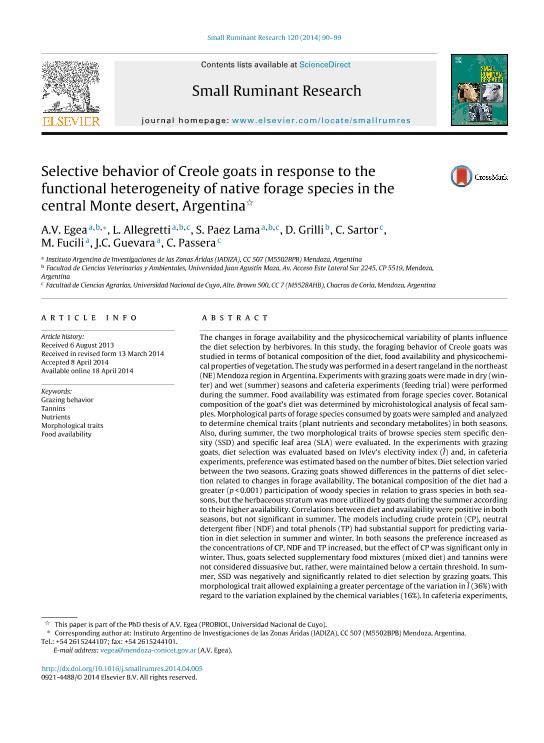Artículo
Selective behavior of Creole goats in response to the functional heterogeneity of native forage species of the central Monte desert, Argentina
Egea, Angela Vanina ; Allegretti, Liliana Inés; Paez Lama, Sebastián Antonio
; Allegretti, Liliana Inés; Paez Lama, Sebastián Antonio ; Grilli, Diego Javier
; Grilli, Diego Javier ; Sartor, Carmen Elena
; Sartor, Carmen Elena ; Fucili, Mercedes
; Fucili, Mercedes ; Guevara, Juan Carlos
; Guevara, Juan Carlos ; Passera, Carlos Bernardo
; Passera, Carlos Bernardo
 ; Allegretti, Liliana Inés; Paez Lama, Sebastián Antonio
; Allegretti, Liliana Inés; Paez Lama, Sebastián Antonio ; Grilli, Diego Javier
; Grilli, Diego Javier ; Sartor, Carmen Elena
; Sartor, Carmen Elena ; Fucili, Mercedes
; Fucili, Mercedes ; Guevara, Juan Carlos
; Guevara, Juan Carlos ; Passera, Carlos Bernardo
; Passera, Carlos Bernardo
Fecha de publicación:
04/2014
Editorial:
Elsevier
Revista:
Small Ruminant Research
ISSN:
0921-4488
Idioma:
Inglés
Tipo de recurso:
Artículo publicado
Clasificación temática:
Resumen
The changes in forage availability and the physicochemical variability of plants influence the diet selection by herbivores. In this study, the foraging behavior of Creole goats was studied in terms of botanical composition of the diet, food availability and physicochemical properties of vegetation. The study was performed in a desert rangeland in the northeast (NE) Mendoza region in Argentina. Experiments with grazing goats were made in dry (winter) and wet (summer) seasons and cafeteria experiments (feeding trial) were performed during the summer. Food availability was estimated from forage species cover. Botanical composition of the goat?s diet was determined by microhistological analysis of fecal samples. Morphological parts of forage species consumed by goats were sampled and analyzed to determine chemical traits (plant nutrients and secondary metabolites) in both seasons. Also, during summer, the two morphological traits of browse species stem specific density (SSD) and specific leaf area (SLA) were evaluated. In the experiments with grazing goats, diet selection was evaluated based on Ivlev?s electivity index (?I) and, in cafeteria experiments, preference was estimated based on the number of bites. Diet selection varied between the two seasons. Grazing goats showed differences in the patterns of diet selection related to changes in forage availability. The botanical composition of the diet had a greater (p < 0.001) participation of woody species in relation to grass species in both sea-sons, but the herbaceous stratum was more utilized by goats during the summer according to their higher availability. Correlations between diet and availability were positive in both seasons, but not significant in summer. The models including crude protein (CP), neutral detergent fiber (NDF) and total phenols (TP) had substantial support for predicting variation in diet selection in summer and winter. In both seasons the preference increased as the concentrations of CP, NDF and TP increased, but the effect of CP was significant only in winter. Thus, goats selected supplementary food mixtures (mixed diet) and tannins were not considered dissuasive but, rather, were maintained below a certain threshold. In summer, SSD was negatively and significantly related to diet selection by grazing goats. This morphological trait allowed explaining a greater percentage of the variation in ?I (36%) with regard to the variation explained by the chemical variables (16%). In cafeteria experiments, in summer, the optimization of nutrient intake rate through consumption of species with low SSD values represented a best explanation for the preferences observed, whereas the hypotheses of minimization of secondary metabolites and maximization of nutrients were not able to fully explain the preferences observed in cafeteria experiments. To conclude, dietary decisions by goats in desert rangelands could be interpreted in terms of intake rate optimization and complementation of nutrients and secondary compounds, rather than by explanations involving the isolated effects of nutrient intake maximization or tannin intake minimization.
Archivos asociados
Licencia
Identificadores
Colecciones
Articulos(CCT - MENDOZA)
Articulos de CTRO.CIENTIFICO TECNOL.CONICET - MENDOZA
Articulos de CTRO.CIENTIFICO TECNOL.CONICET - MENDOZA
Articulos(IHEM)
Articulos de INST. HISTOLOGIA Y EMBRIOLOGIA DE MEND DR.M.BURGOS
Articulos de INST. HISTOLOGIA Y EMBRIOLOGIA DE MEND DR.M.BURGOS
Citación
Egea, Angela Vanina; Allegretti, Liliana Inés; Paez Lama, Sebastián Antonio; Grilli, Diego Javier; Sartor, Carmen Elena; et al.; Selective behavior of Creole goats in response to the functional heterogeneity of native forage species of the central Monte desert, Argentina; Elsevier; Small Ruminant Research; 120; 1; 4-2014; 90-99
Compartir
Altmétricas



